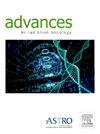The Impact of Synchrotron Microbeam Radiation Therapy Combined With Broad Beam in a Preclinical Breast Cancer Model
IF 2.2
Q3 ONCOLOGY
引用次数: 0
Abstract
Purpose
Both local tumor control and distant metastasis are important indicators of the efficacy of radiation therapy treatment. Synchrotron microbeam radiation therapy (MRT), spatially fractionated radiation delivered at ultrahigh dose rates, shows remarkable normal tissue sparing with excellent local control in some models. Some MRT regimens trigger an antitumor immune response that contributes not only to the local but also to systemic treatment efficacy. Despite recent advances in the treatment of primary breast cancer, metastatic disease is still the major cause of treatment failure in the clinic. Here, in an aggressive preclinical triple-negative breast cancer model, we compared local tumor response and metastasis following different MRT treatment programs.
Methods and Materials
4T1.2 mouse mammary tumors were treated with 300 Gy peak/7 Gy valley dose MRT and/or 8 Gy broad beam (BB) radiation, all delivered as daily fractionated programs (3 consecutive daily sessions of either MRT or BB or 1 MRT combined with 2 BB sessions, the first or last of the 3 fractions). The mice were euthanized on day 9 post last irradiation, when unirradiated control animals reached an ethical endpoint. Primary tumors were collected to evaluate immune cell prevalence, while lungs, spinal cords, and locoregional lymph nodes were collected to measure metastatic burden. In parallel, local tumor growth and survival were monitored.
Results
The combined MRT/BB treatment shifted the balance between pro- and antitumorigenic macrophages toward the accumulation of antitumorigenic macrophages in the tumor. Monitoring of the tumor volume and animal health indicated the benefit of the combined MRT/BB treatment for local control and treatment tolerance, while animal survival was only marginally longer for one combined schedule. The metastatic burden was similar for all 4 treatment schedules.
Conclusions
The addition of a single MRT to BB treatment improved the primary tumor response. This provides a basis for future experiments incorporating adjuvant immunotherapy or chemotherapy to improve local and systemic treatment outcomes.
同步微束联合宽束放射治疗对临床前乳腺癌模型的影响
目的肿瘤局部控制和远处转移是评价放疗疗效的重要指标。同步微束放射治疗(MRT)是一种以超高剂量率进行空间分割的放射治疗,在一些模型中显示出显著的正常组织保留和良好的局部控制。一些MRT方案引发抗肿瘤免疫反应,不仅有助于局部治疗,而且有助于全身治疗效果。尽管最近原发性乳腺癌的治疗取得了进展,但转移性疾病仍然是临床上治疗失败的主要原因。在一个侵袭性临床前三阴性乳腺癌模型中,我们比较了不同MRT治疗方案后的局部肿瘤反应和转移。方法和材料4t1.2小鼠乳腺肿瘤接受300 Gy峰值/7 Gy谷剂量MRT和/或8 Gy宽束(BB)辐射治疗,所有治疗均为每日分次方案(连续3次每日MRT或BB或1次MRT联合2次BB, 3次分次中的第一次或最后一次)。在最后一次辐照后的第9天,当未辐照的对照动物达到伦理终点时,对小鼠实施安乐死。收集原发肿瘤以评估免疫细胞的患病率,同时收集肺、脊髓和局部区域淋巴结以测量转移负担。同时,监测局部肿瘤的生长和生存。结果MRT/BB联合治疗使促致和抗致瘤巨噬细胞之间的平衡向肿瘤中抗致瘤巨噬细胞的积累转变。对肿瘤体积和动物健康的监测表明,MRT/BB联合治疗对局部控制和治疗耐受性有好处,而联合治疗方案的动物生存时间仅略微延长。所有4种治疗方案的转移性负担相似。结论在BB治疗基础上加单次MRT可改善原发肿瘤反应。这为未来结合辅助免疫治疗或化疗来改善局部和全身治疗结果的实验提供了基础。
本文章由计算机程序翻译,如有差异,请以英文原文为准。
求助全文
约1分钟内获得全文
求助全文
来源期刊

Advances in Radiation Oncology
Medicine-Radiology, Nuclear Medicine and Imaging
CiteScore
4.60
自引率
4.30%
发文量
208
审稿时长
98 days
期刊介绍:
The purpose of Advances is to provide information for clinicians who use radiation therapy by publishing: Clinical trial reports and reanalyses. Basic science original reports. Manuscripts examining health services research, comparative and cost effectiveness research, and systematic reviews. Case reports documenting unusual problems and solutions. High quality multi and single institutional series, as well as other novel retrospective hypothesis generating series. Timely critical reviews on important topics in radiation oncology, such as side effects. Articles reporting the natural history of disease and patterns of failure, particularly as they relate to treatment volume delineation. Articles on safety and quality in radiation therapy. Essays on clinical experience. Articles on practice transformation in radiation oncology, in particular: Aspects of health policy that may impact the future practice of radiation oncology. How information technology, such as data analytics and systems innovations, will change radiation oncology practice. Articles on imaging as they relate to radiation therapy treatment.
 求助内容:
求助内容: 应助结果提醒方式:
应助结果提醒方式:


